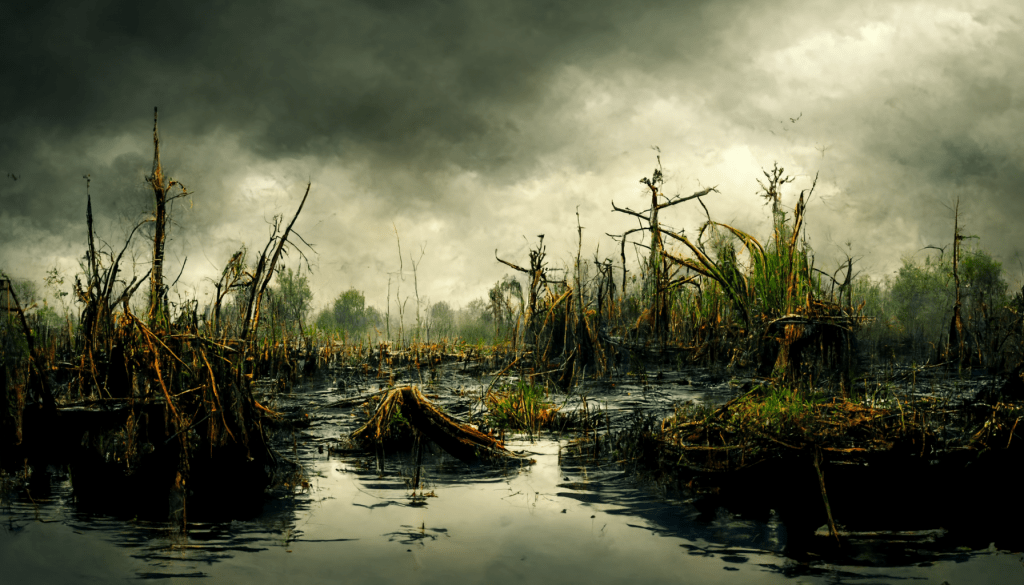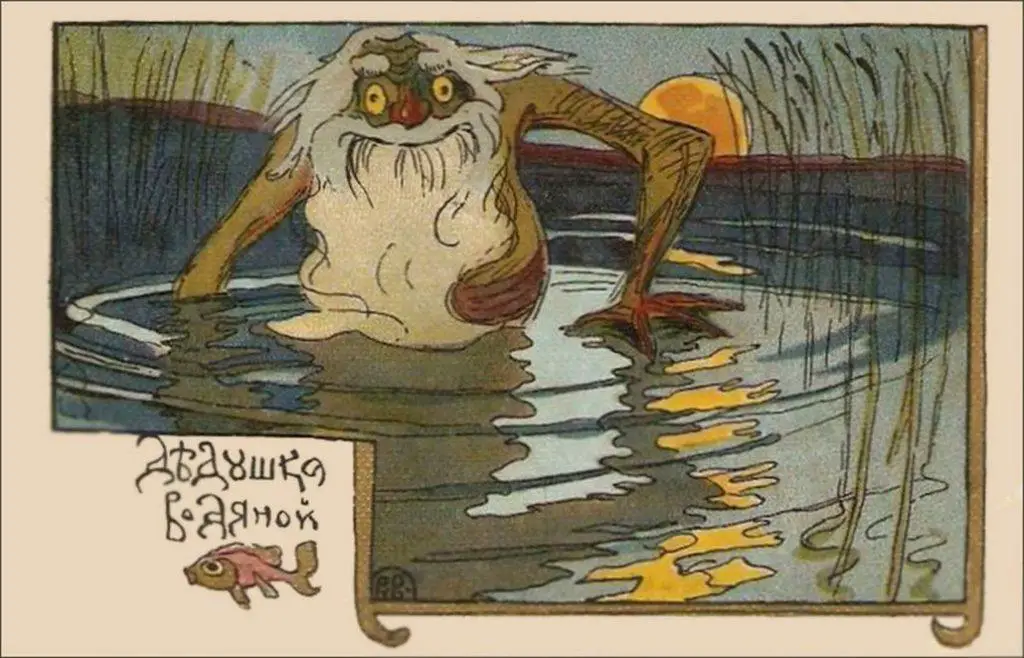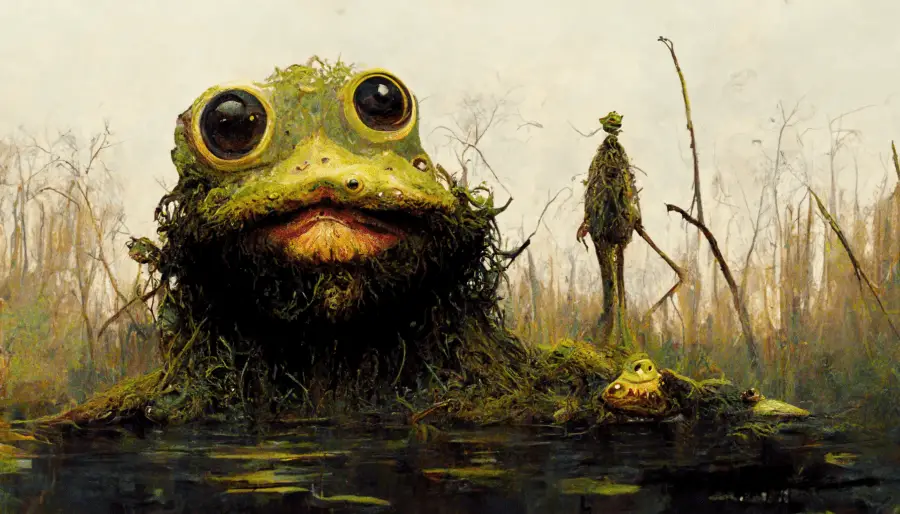Share the Lore!
By: Alex Postrado
A Horror Lurks in the Swamp: Vodyanoy
Oftentimes, he is a naked, old man with a frog-like face and a long, tangled beard.
Other times, he is a green-skinned humanoid figure with webbed hands and feet.
In lesser-known versions of the lore, he can even take the form of a child or an animal of his liking 一 further proving that he is, in fact, the master shapeshifter of the Slavic wetlands.
The vodyanoy.
Among the several water-dwelling monsters in Eastern Europe, the vodyanoy 一 perhaps 一 is one of the best known!
Traditionally, he serves as the explanation for almost every “watery misfortune” happening across the East Slavs.
And depending on the region, he is known by a different, yet similar-sounding name.
Though one thing stays the same in each vodyanoy story.
It is the fact that whenever a vodyanoy is near, either of the two can be expected: death or mayhem.
Now, which one are you ready to hear about first?

What is the Vodyanoy?
Ancient Slavic folklore tells of begrudging creatures residing in the murky waters of the region.
They are called the vodyanoy.
The name vodyanoy or vodyanoi came from the Russian водяно́й, meaning “from the water” or “watery“.
And they are said to be malevolent water spirits typically found in rivers, swamps, and lakes 一 particularly those with strong currents.
Described in stories as spiteful entities 一 they are fond of drowning innocent humans they dislike even for the pettiest of reasons!
Their common victims? People bathing after sundown or on a sacred day, or anyone who forgets to make the sign of the cross before jumping in the water.
These unfortunate ones will then get dragged into the deep waters, where they will be forced to suffer the wrath of the vodyanoy.
And to rub salt in the wound, the last face that they will see before their likely death is that of a monstrous hybrid of a naked, old man and a frog.
Though this description further varies, the most common version pictures them as having dirty hair tangled with seaweed, scaly skin of gray and green shades, and a tail like that of a big fish.
In other versions of the story, however, they are said to have a human form 一 but one with longer than normal toes, paws in place of hands, a couple of horns on the head, eyes like that of burning coals, and tails on their backs.
Furthermore, some interesting depictions can also be found in a separate retelling of the lore.
One, where the vodyanoy is described as overgrown grass; another, as a man in a red shirt walking on the shore; and the rest as either a pig or a fish.
Alleged sightings of the vodyanoy tell of him riding the length of the river on a half-sunken log — an element which has become a staple to his legend.
Along with, of course, the element of mayhem that the vodyanoy is quick to unleash when rubbed the wrong way!
Between destroyed dams and water mills, drowned people and animals 一 it is evident that the vodyanoy are not forgiving creatures.
The worst part is, it does not end there!
The difficult monsters are also known for their desire to marry women who have drowned in their territory or have been disinherited.
Bitter and green with envy 一 vodyanoy are fond of impregnating married women, as well.
And to avoid such complications and misery 一 local fisherfolks, millers, and even bee-keepers offer various sacrifices to make peace with the vodyanoy.

Vodyanoy vs. Vodnik
Undoubtedly popular, the tales of the vodyanoy are predominantly widespread in East Slavic regions. While in the Czech, Slovene, and Slovak regions, the vodnik or vodnici are more well-known.
Vodnici are also water creatures.
And they are similar to the Wasserman or Nix of German folklore which are mythical aquatic life forms residing in underwater palaces.
Notably divergent from the East Slavic account of the vodyanoy, vodnici are said to have nearly human-like forms and habits — except for their gills, webbed fingers, and green skin and hair.
And seemingly a complete opposite to the naked vodyanoy, the vodnici often dress in bizarre human clothing:
With their patched shirts and eccentric hats with “long speckled ribbons“, coupled with their typically unshaven face — making them appear as a vagrant.
Another notable quality of the vodnici is their ability to remain outside ponds 一 their place of dwelling 一 for a significant amount of time.
They are also said to be neither inherently benevolent nor purely evil.
Some vodnici enjoy drowning people swimming in their territory — storing the souls of their victims in teacups.
While others enjoy harmless activities like playing cards, smoking pipes, or idly lounging around their dwelling.
Other Related Spirits to the Vodyanoy
As mentioned earlier, the vodyanoy are far from being the only water-related creatures from Slavic folklore.
In fact, there are several others and the list includes the ruler of all the vodyanoy:
Tsar Vodyanik.
Sometimes also referred to as Vodyan Tsar, Tsar Vodyanik is said to be the Elder Vodyanoy who watches over all of the others and lives in the Russian North.
Appearing as a club-wielding, old man, he is said to regularly sit on black clouds and create new lakes and rivers with the rain.
Another one of the known companions of the vodyanoy 一 and, sometimes, even the forest and marsh deity, leshy 一 is the bolotnik.
Similarly, an old-looking man with a long, green beard 一 the bolotnik is believed to be close relatives with the vodyanoy.
And much like their cousin, the bolotnik is said to also be especially dangerous as they have the habit of luring people into the swamp 一 done with the use of their ability to produce enchanting lights and mimic the sounds of various animals.

In most stories, the bolotnik is painted as a solitary creature. Though other accounts tell of him having a wife 一 bolotnitsa.
And that takes us to northern Russia’s rusalka 一 also called vodyanitsa 一 the said-to-be wife 一 other times, female counterpart 一 of the menacing vodyanoy.
While this part of the lore involves contradicting details, as rusalki are argued by some to be separate entities from vodyanitsy, there is a consensus that vodyanitsy are actually the creatures that fit the shoe better.
The lore has it that vodyanitsy are beautiful, green-haired water spirits.
They could change shape and appear as white swans or golden-finned fishes.
And they could either be sea-dwelling or freshwater-inhabiting 一 with the former, being the more aggressive of the two.
Does the Vodyanoy Exist?
The thing is, no matter the lack of proof, some would still swear that supernatural entities — such as the vodyanoy — exist in the real world.
This is reflected by the practices and traditions people observe to appease such creatures. But, more often than not, the handed-down belief is only based on stories — those that have been present since ancient times.
And that is particularly true with the vodyanoy.
There is practically no known way to prove that spiteful, frog-like monsters exist outside of folklore.
But, we still talk about them.
And, perhaps, it is because — in some ways — the belief in creatures like the vodyanoy, instead of harming us, actually keeps us safe and wary.
Creatively reminding us that danger could lurk anywhere — even in the most ingenious of waters the Slavic wetlands have to offer.
References:
Vodyanoy - Slavic Religion Vodnik - Myths And Folklore The Proud, Demanding Vodyanoy Rules Russia’s Rivers And Lakes Malicious Myths: The Vodyanoy (Водяно́й) Vodyanoi: Evil Water Spirit In Ancient Beliefs Of The Slavs
